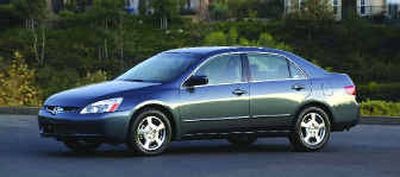Honda does Accord Hybrid right

Honda’s new Accord Hybrid is more fun than a responsible car has a right to be.
Its EPA mileage ratings of 29 city/37 highway certify it the world’s most fuel-efficient six-cylinder sedan.
But one expects great fuel economy from a Honda hybrid.
What one might not expect is that this one is as quick and comfortable as anything in its class.
Once upon a time, we all figured extreme fuel efficiency would be the modern hair shirt — righteous but painful.
Honda and Toyota have given lie to dire expectation with an ever-broadening selection of accommodating hybrids, and Ford joined them last year with the hybrid Escape.
But Honda has upped the ante with the 2005 Accord, which is destined to carry hybrid technology deep into the mainstream.
For starters, nothing about this car screams hybrid. It’s virtually identical to its siblings and its standard-equipment list includes leather-covered and heated seats, automatic climate control, cruise control, an audio system with a six-disc CD changer and satellite radio, anti-lock brakes, curtain-style airbags and automatic transmission.
But here’s the fun part: by pairing a wafer-thin electric motor with a 3-liter V-6 engine, Honda has made a hybrid that scoots from zero to 60 mph in 6.7 seconds. That’s quicker, by three-tenths of a second, than the regular V-6-powered Accord.
Also, the Accord Hybrid should see 633 miles between fill-ups.
Who knew saving the planet could be so much fun?
The benefits extend beyond fuel-efficiency to also include reduced emissions. The Accord Hybrid won’t restore the ozone layer by itself, but it nudges us in the right direction.
There is a price, of course. The hybrid fetches about $3,000 more than a comparably equipped V-6 Accord. The trunk has lost 2.8 cubic feet to the vault where the battery pack is stored, and the rear seatbacks are rigid and don’t fold down.
Eagle-eyed observers will notice the unique grille color, five-spoke alloy wheels, modest decklid spoiler and “hybrid” badges; otherwise, this for all appearances is your basic, garden-variety Accord.
Same on the inside, where the only clues are a “charge-and-assist” bar graph, battery-status graphic and a mysterious indicator labeled “ECO.”
If you need to let the world know where your sympathies lie, this is not your car. No one will ever guess you’re green.
But back to the issue of performance: What explains this unexpected combination of muscle and thrift?
It stems from the nature of the electric motor.
In terms of horsepower, electric motors are the original 97-pound weakling. Under full throttle, the tiny (it’s just 2.7 inches wide) electric motor/generator only makes 16 hp. But electric motors are torque monsters. This one, which Honda calls Integrated Motor Assist (IMA), makes 100 pound-feet, which gets mixed in with the 217 the gas engine makes.
And because they make peak torque at low engine revolutions, electric motors ideally complement gasoline engines, which don’t hit their stride until they’ve spun up into the midranges.
The hybrid Accord is quick off the line and the power builds as the engine revs reach the gas engine’s sweet spot. Passing is a non-issue.
IMA is sandwiched between the latitudinally mounted six and Honda’s very good five-speed automatic transmission.
Under conditions that require minimal torque — freeway driving, cruising along under 3,500 rpm — the system shuts down three of its cylinders to further slash fuel consumption. Ask for a little acceleration and the electric motor kicks in to help. Ask for more and the three slumbering cylinders pop awake.
Except for the green-glowing “ECO” light, the transition is transparent to the user.
Slightly less transparent is another nifty, fuel-saving feature called Auto Stop. Under normal conditions, the powertrain is programmed to shut down at idle. Pull up to a stop sign and it takes a breather, while the electrical system keeps the AC running and the CD player singing.
Lift your foot from the brake pedal and it fires up with a slight but perceptible shudder.
You’d be forgiven for thinking this is the end of Honda’s trickery, but there’s more. In a feat of real engineering derring-do, they’ve even learned how to capture the energy produced by the forces of deceleration and braking.
Lift your foot from the throttle and the IMA recaptures energy that normally is lost as heat. Step on the brake, and precious electricity is routed to the battery for storage.
Indeed, the Accord reaps the rewards of a technology now in its third generation. From behind the wheel, it feels almost indistinguishable from its siblings. There is that little shudder at takeoff and a reviewer is obliged to notice the slightest numbness at center in the electric steering system.
The only other distinctive characteristic of the Hybrid’s handling package is torque steer, which plagues every overpowered front-wheel-drive car. Put your foot to the floor and the Accord responds with a slight tug to one side on the steering wheel.
With the Accord Hybrid, we have entered a new world of mainstream motoring: Look around at all the inefficient, uninspiring cars on the road. Given the option of driving the one that is ultimately efficient and surprisingly fun, who wouldn’t come up with the extra three bills?